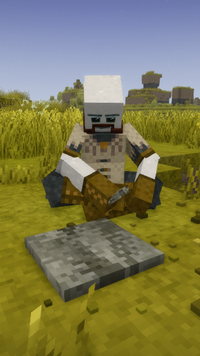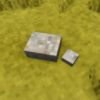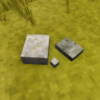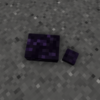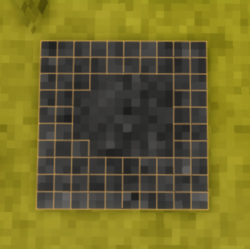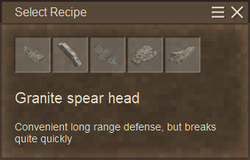Knapping/es: Difference between revisions
(Created page with "Talla Lítica") |
(Created page with "<youtube>uymFczlVtAE</youtube>") Tags: Mobile edit Mobile web edit |
||
| (29 intermediate revisions by 4 users not shown) | |||
| Line 1: | Line 1: | ||
<languages /> | <languages /><br> | ||
<div class="mw-translate-fuzzy"> | |||
[[File:PlayerKnapping.png|200px|thumb|Jugador tallando]] | |||
¡Hora de hacer tus primeras herramientas! La talla lítica es uno de los primeros tipos de fabricación disponible para el jugador, permitiendo hacer cabezas de herramientas y armas primitivas. | |||
</div> | |||
<div lang="en" dir="ltr" class="mw-content-ltr"> | |||
Time to make your first tools! '''Knapping''' is one of the earliest types of crafting available to the player, which allows them to make primitive tools and weapons out of stone. | |||
</div> | |||
<div class="mw-translate-fuzzy"> | |||
== | ==Adquiriendo Piedras== | ||
Piedras sueltas, pedernal y obsidiana pueden encontrarse en el suelo o forajeando. Puedes recolectarlos usando click-izquierdo.<br/> | |||
Por orden de la fuerza de las herramientas resultantes, los mejores materiales para tallar son: '''Obsidiana > Pedernal > Los demás tipos de piedra.''' | |||
</div> | |||
<div lang="en" dir="ltr" class="mw-content-ltr"> | |||
Loose stones, flint and obsidian can be found on the ground when foraging. You can collect them by using {{LMB}}.<br> | |||
By order of resulting tool strength, the best stones for knapping are: '''Obsidian > Flint > All other stone types.''' | |||
</div> | |||
<div class="mw-translate-fuzzy"> | |||
== Piedras Tallables== | |||
Solo ciertos tipos de materiales pueden usarse para tallar herramientas y armas de piedra: | |||
:{| class="wikitable" | |||
|- | |||
! width: 40px | Imagen | |||
! width: 200px | Material | |||
! width: 200px| Descripción | |||
|- | |||
| style="text-align:center;" | [[File:LooseStones.png|100px]] | |||
| style="text-align:center;" | Piedra | |||
| El material más común, aunque solo ciertos tipos pueden usarse: granito, andesita, chert, basalto y peridotita. Otros tipos de piedra son demasiado blandas para tallar, como: tiza, conglomerada, caliza, arcillolita, arenisca, lutita, filita, pizarra, kimberlita, escoria, toba, bauxita, halita, suevita, y mármol. | |||
|- | |||
| style="text-align:center;" | [[File:LooseFlint.png|100px]] | |||
| style="text-align:center;" | Pedernal | |||
| Menos común. Puede encontrarse comúnmente al lado de otras piedras sueltas o por su cuenta. Ligeramente mejor material para hacer cabezas de herramientas y, a diferencia de las piedras, puede usarse para hacer puntas de flechas. | |||
|- | |||
| style="text-align:center;" | [[File:LooseObsidian.png|100px]] | |||
| style="text-align:center;" | Obsidiana | |||
| Más comúnmente encontradas en áreas donde la capa de piedra superior es basalto. El mejor material no metal para hacer herramientas. | |||
|} | |||
</div> | |||
=== | <div lang="en" dir="ltr" class="mw-content-ltr"> | ||
Only certain materials can be used to craft tool and weapon heads: | |||
</div> | |||
:{| class="wikitable" | |||
|- | |||
! width: 40px | <span lang="en" dir="ltr" class="mw-content-ltr">Image</span> | |||
! width: 200px | <span lang="en" dir="ltr" class="mw-content-ltr">Material</span> | |||
! width: 200px| <span lang="en" dir="ltr" class="mw-content-ltr">Description</span> | |||
|- | |||
| style="text-align:center;" | [[File:LooseStones.png|100px]] | |||
| style="text-align:center;" | <span lang="en" dir="ltr" class="mw-content-ltr">Stone</span> | |||
| <span lang="en" dir="ltr" class="mw-content-ltr">The most common material, though only certain types of stones can be used: granite, andesite, chert, basalt and peridotite. Other stone types can be too soft to knap, such as; chalk, conglomerate, limestone, claystone, sandstone, shale, phyllite, slate, kimberlite, scoria, tuff, bauxite, halite, suevite, and marble.</span> | |||
|- | |||
| style="text-align:center;" | [[File:LooseFlint.png|100px]] | |||
| style="text-align:center;" | <span lang="en" dir="ltr" class="mw-content-ltr">Flint</span> | |||
| <span lang="en" dir="ltr" class="mw-content-ltr">A little bit less common. Found commonly alongside other loose stones or on their own. Slightly better material to make tool heads from and, unlike stones, can be used to make arrow heads.</span> | |||
|- | |||
| style="text-align:center;" | [[File:LooseObsidian.png|100px]] | |||
| style="text-align:center;" | <span lang="en" dir="ltr" class="mw-content-ltr">Obsidian</span> | |||
| <span lang="en" dir="ltr" class="mw-content-ltr">Most commonly found in areas where the top layer of rock is basalt. It's the best non-metal material for tools.</span> | |||
|} | |||
== | <div class="mw-translate-fuzzy"> | ||
==Dando Forma a las Piedras== | |||
[[File:KnapSurface.png|250px|right|thumb|Superficie de corte.]] | |||
* Para empezar a tallar, necesitarás al menos dos piezas del mismo material (pedernal, granito, andesita, chert, basalto, peridotita o obsidiana) y, mientras los sostienes en la mano activa, Agáchate y dale a click-derecho. Si estás usando pedernal, empezarás a tallar inmediatamente. Con otras piedras, tendrás que colocar una piedra en el suelo primero y presionar click-derecho sobre ella con la segunda piedra. | |||
* Tras esto, una caja de dialogo aparecerá, permitiéndote elegir que cabeza herramienta quieres hacer. | |||
* Una vez seleccionada la herramienta, una superficie plana de vóxeles aparecerá en el suelo, con algunos de ellos resaltados con un borde naranja. Sujetando una piedra del mismo o cualquier material, talla los vóxeles sujetando el click o a tu propio ritmo hasta que no quede ningún vóxel resaltado. Puedes intentar destruir grupos de vóxeles desconectándolos del objeto de trabajo principal. Considera sentarte usando G para acercarte a la superficie de tallado. Si consideras al movimiento de la cámara muy distractorio, puedes abir una caja de dialogo (como el chat) o sujetar Alt para liberar el ratón. | |||
* Una vez hayas terminado, recibirás la cabeza de herramienta. | |||
</div> | |||
<div lang="en" dir="ltr" class="mw-content-ltr"> | |||
[[File:KnapSurface.png|250px|right|thumb|Knapping Surface.]] | |||
</div> | |||
<div lang="en" dir="ltr" class="mw-content-ltr"> | |||
* To start knapping, you need at least 2 of the same knappable material (flint, granite, andesite, chert, basalt, peridotite or obsidian) and, while holding them, Sneak + {{RMB}} on the ground. If you’re using flint, you will begin knapping right away. With other stones, you have to place one stone one the ground first and {{RMB}} on it with the second one in your hand. | |||
* After doing this, a dialog box will show up, letting you choose what tool head you want to make by clicking on it. | |||
* Once you've selected a tool, a 10x10 flat grid of voxels will appear on the ground, some of them highlighted with an orange outline. While holding another stone of the same or any material, knap away voxels either by holding down or clicking at your own pace, until no highlighted voxel remains. You can break away groups of voxels by disconnecting them from the main work piece. Consider sitting down using {{Keypress|G}} to get closer to the crafting surface. If you find the free camera distracting while knapping, you can open any dialog box (such as the chat) or hold down {{Keypress|Alt}} to unlock the free mouse. | |||
* Once you're done you will receive your tool head. | |||
</div> | |||
= | <div class="mw-translate-fuzzy"> | ||
[[File:KnapDiagBox.png|left|250px|thumb|Caja de diálogo que te permite seleccionar la herramienta]] {{Protip | |||
|* El tipo de piedra usada para remover vóxeles no necesita ser del mismo material o si quiera de un tipo de piedra tallable (e.g. arenisca, conglomerado, etc.). | |||
* No te preocupes por hacer errores, el juego previene a jugadores de romper partes requeridas para formar la herramienta. | |||
* En multijugador, si otro jugador tiene piedras, pueden ayudar a completar la herramienta más rápidamente. Cuando la cabeza de herramienta esté lista, se agregará al inventario del jugador que removió el último vóxel. | |||
}} | |||
</div> | |||
<div lang="en" dir="ltr" class="mw-content-ltr"> | |||
{{Protip | |||
* | |* The stone used to remove voxels doesn't need to be of the same or even a knappable material (e.g. sandstone, conglomerate, etc.). | ||
* Don't worry about making mistakes, the game prevents players from breaking the parts required to shape the tool. | |||
* In multiplayer, if another player has knapping stones, they can also work on the piece to complete the tool head faster. When the tool head is completed, it will jump into the inventory of the player who removes the last voxel. | |||
}} | |||
Don't worry about making mistakes, the game prevents players from breaking the parts required to shape the tool. | </div> | ||
{{-}} | |||
<div class="mw-translate-fuzzy"> | |||
==Terminando la Herramienta== | |||
Una vez hayas terminado y haya recibido la cabeza de herramienta, colocala en el cuadro de fabricación de tu inventario (E) con un palo o hueso para recibir tu herramienta terminada. Con pedernal, puedes hacer un hacha, azada, cuchillo, pala, lanza y puntas de flechas. Con cualquier otro tipo de piedra, jugadores pueden hacer todas las herramientas listadas a excepción de las puntas de flechas. Las herramientas hechas de pedernal tienden a tener mayor durabilidad que sus contrapartes hechas de andesita, basalto, granito o peridotita; y herramientas con mangos de hueso tienen 10 puntos de durabilidad extra. | |||
</div> | |||
[[File:Stone_and_Bone_Tools.gif|300px|right|thumb|Creación de una herramienta]] | |||
== | <div lang="en" dir="ltr" class="mw-content-ltr"> | ||
Once you're done and received your tool head, place it into the crafting grid in your inventory ({{Keypress|E}}) with a stick or bone to receive your finished tool. With flint, players can make an axe, hoe, knife, shovel, spear and arrowheads. With any other stone, players can make all of the tools listed above except arrowheads. Tool heads made of flint or obsidian tend to last longer than counterparts made of andesite, basalt, chert, granite, or peridotite; and tools with a bone handle tend to have 10 points of extra durability | |||
</div> | |||
{{-}} | |||
==Video-Tutorial: Cómo Tallar Herramientas de Piedra== | |||
<div class="mw-translate-fuzzy"> | |||
¡Gracias a SmileOnSpeedDial por crear y compartir con la comunidad de VS! | |||
<br> | |||
</div> | |||
<br> | |||
<youtube>uymFczlVtAE</youtube> | |||
{{-}} | |||
{{Game navbox}} | |||
[[Category:Guides{{#translation:}}]] | |||
{{ | |||
Latest revision as of 19:53, 26 December 2023
¡Hora de hacer tus primeras herramientas! La talla lítica es uno de los primeros tipos de fabricación disponible para el jugador, permitiendo hacer cabezas de herramientas y armas primitivas.
Time to make your first tools! Knapping is one of the earliest types of crafting available to the player, which allows them to make primitive tools and weapons out of stone.
Adquiriendo Piedras
Piedras sueltas, pedernal y obsidiana pueden encontrarse en el suelo o forajeando. Puedes recolectarlos usando click-izquierdo.
Por orden de la fuerza de las herramientas resultantes, los mejores materiales para tallar son: Obsidiana > Pedernal > Los demás tipos de piedra.
Loose stones, flint and obsidian can be found on the ground when foraging. You can collect them by using ![]() .
.
By order of resulting tool strength, the best stones for knapping are: Obsidian > Flint > All other stone types.
Piedras Tallables
Solo ciertos tipos de materiales pueden usarse para tallar herramientas y armas de piedra:
Only certain materials can be used to craft tool and weapon heads:
Dando Forma a las Piedras
- Para empezar a tallar, necesitarás al menos dos piezas del mismo material (pedernal, granito, andesita, chert, basalto, peridotita o obsidiana) y, mientras los sostienes en la mano activa, Agáchate y dale a click-derecho. Si estás usando pedernal, empezarás a tallar inmediatamente. Con otras piedras, tendrás que colocar una piedra en el suelo primero y presionar click-derecho sobre ella con la segunda piedra.
- Tras esto, una caja de dialogo aparecerá, permitiéndote elegir que cabeza herramienta quieres hacer.
- Una vez seleccionada la herramienta, una superficie plana de vóxeles aparecerá en el suelo, con algunos de ellos resaltados con un borde naranja. Sujetando una piedra del mismo o cualquier material, talla los vóxeles sujetando el click o a tu propio ritmo hasta que no quede ningún vóxel resaltado. Puedes intentar destruir grupos de vóxeles desconectándolos del objeto de trabajo principal. Considera sentarte usando G para acercarte a la superficie de tallado. Si consideras al movimiento de la cámara muy distractorio, puedes abir una caja de dialogo (como el chat) o sujetar Alt para liberar el ratón.
- Una vez hayas terminado, recibirás la cabeza de herramienta.
- To start knapping, you need at least 2 of the same knappable material (flint, granite, andesite, chert, basalt, peridotite or obsidian) and, while holding them, Sneak +
 on the ground. If you’re using flint, you will begin knapping right away. With other stones, you have to place one stone one the ground first and
on the ground. If you’re using flint, you will begin knapping right away. With other stones, you have to place one stone one the ground first and  on it with the second one in your hand.
on it with the second one in your hand. - After doing this, a dialog box will show up, letting you choose what tool head you want to make by clicking on it.
- Once you've selected a tool, a 10x10 flat grid of voxels will appear on the ground, some of them highlighted with an orange outline. While holding another stone of the same or any material, knap away voxels either by holding down or clicking at your own pace, until no highlighted voxel remains. You can break away groups of voxels by disconnecting them from the main work piece. Consider sitting down using G to get closer to the crafting surface. If you find the free camera distracting while knapping, you can open any dialog box (such as the chat) or hold down Alt to unlock the free mouse.
- Once you're done you will receive your tool head.
Protip:
* El tipo de piedra usada para remover vóxeles no necesita ser del mismo material o si quiera de un tipo de piedra tallable (e.g. arenisca, conglomerado, etc.). * No te preocupes por hacer errores, el juego previene a jugadores de romper partes requeridas para formar la herramienta. * En multijugador, si otro jugador tiene piedras, pueden ayudar a completar la herramienta más rápidamente. Cuando la cabeza de herramienta esté lista, se agregará al inventario del jugador que removió el último vóxel. |
Protip:
* The stone used to remove voxels doesn't need to be of the same or even a knappable material (e.g. sandstone, conglomerate, etc.). * Don't worry about making mistakes, the game prevents players from breaking the parts required to shape the tool. * In multiplayer, if another player has knapping stones, they can also work on the piece to complete the tool head faster. When the tool head is completed, it will jump into the inventory of the player who removes the last voxel. |
Terminando la Herramienta
Una vez hayas terminado y haya recibido la cabeza de herramienta, colocala en el cuadro de fabricación de tu inventario (E) con un palo o hueso para recibir tu herramienta terminada. Con pedernal, puedes hacer un hacha, azada, cuchillo, pala, lanza y puntas de flechas. Con cualquier otro tipo de piedra, jugadores pueden hacer todas las herramientas listadas a excepción de las puntas de flechas. Las herramientas hechas de pedernal tienden a tener mayor durabilidad que sus contrapartes hechas de andesita, basalto, granito o peridotita; y herramientas con mangos de hueso tienen 10 puntos de durabilidad extra.
Once you're done and received your tool head, place it into the crafting grid in your inventory (E) with a stick or bone to receive your finished tool. With flint, players can make an axe, hoe, knife, shovel, spear and arrowheads. With any other stone, players can make all of the tools listed above except arrowheads. Tool heads made of flint or obsidian tend to last longer than counterparts made of andesite, basalt, chert, granite, or peridotite; and tools with a bone handle tend to have 10 points of extra durability
Video-Tutorial: Cómo Tallar Herramientas de Piedra
¡Gracias a SmileOnSpeedDial por crear y compartir con la comunidad de VS!
| Wiki Navigation | |
|---|---|
| Vintage Story | Guías • Preguntas más frecuentes (FAQ) • Vintage Story Original Soundtrack • Versiones • Controles |
| Mecánicas de juego | Fabricación • Talla Lítica • Alfarería • Herrería • Cocina • Temperatura • Hambre • Minería • Estabilidad temporal • Energía mecánica • Comercio • Agricultura • Ganadería |
| Mundo | Generación del Mundo • Biomas • Clima • Tormentas temporales |
| Objetos | Herramientas • Armas • Armadura • Ropa • Mochilas • Materiales • Comida |
| Bloques | Terreno • Plantas • Decorativo • Iluminación • Functional • Minerales |
| Entidades | Entidades hostiles • Animales • NPCs • Jugadores |
| Miscellaneous | List of client commands • Lista de comandos del servidor • Guia de iniciación de Modo creativo • Bot System • Cómo utilizar Worldedit • Cinematic Camera • Adjustable FPS Video Recording • ServerBlockTicking |
